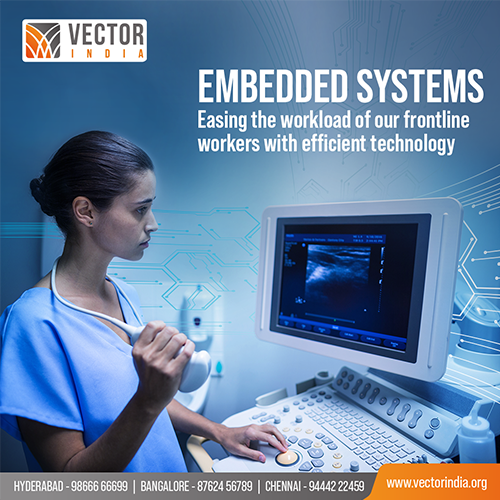


COVID-19 left us vulnerable to unprepared dangers that we have never encountered before. Due to its high transmissibility and the lack of cure or vaccine, technology was our only resort to handle the pandemic. With growing cases every day, the medical and healthcare industry continued its search for digital devices to monitor the infection spread and provide better treatment. Several embedded system-based devices became lifesavers in tackling some of the dire situations during the pandemic. The embedded systems industry as a whole became the frontrunner in saving lives and shaping the future of the healthcare industry.
Infrared Thermal Scanners are employed to immediately identify people with fever or higher temperature than usual, potentially because of COVID-19. It is nothing but an Infrared Temperature Sensor that utilises IR to calculate the temperature of an object. The sensing unit of the device measures the amount of IR energy emitted by people, converts it into temperature values and gives an output based on the I2C communication protocol.
The thermal surveillance cameras at airports work on the same principle. The impact they create in detecting people with elevated temperatures is paramount. They meet the challenges posed by COVID-19 by tracking down a massive number of people within seconds. There is still room for improvement in this technology for increasing the accuracy and reducing the margin of error, giving the embedded systems industry a huge role to play in the future.
As COVID-19 disease spreads by any kind of close interaction or contact with an already infected person, contact tracing becomes a lot more essential to avoid clusters. There are several contact-tracing apps that provide reliable and efficient data of people infected and the hotspots, using various smartphone embedded sensors (GPS, Bluetooth). Apps like Arogya Setu are widely downloaded and used for contact tracing and minimise the spread of the infection. To avoid transmission, there are several game-changing embedded systems-based devices like automated door handles and water taps, contactless Swipe cards, cameras with face detection to replace fingerprint scanners.
There is a need for more software and applications to battle COVID-19. Several research programs are happening around the world to ensure the same. The UK-based ARM-powered AI can spot COVID-19 symptoms based on images of lungs; The University of Waterloo’s convolutional neural network for COVID-19 can detect the infection via chest radiography; there’s just no shortage of interesting developments in technology, which further ensures that the future is indeed bright for the embedded systems industry with an abundance of career opportunities.
One of the primary organs affected by coronavirus is the Lungs. The drop in Oxygen levels is the culprit for several deaths. Pulse Oximeter helps us to avoid this situation by letting us know our oxygen levels. It measures the arterial oxygen saturation in a patient’s blood using an optical sensor. A microcontroller system then converts that value to digital data, which will be sent to a receiver to convert it into an analog signal on display.
The wide adoption of these digital technologies is driving the tremendous growth potential of the embedded systems market and transforming the healthcare industry with innovative and cost-effective ventilators, Personal protection devices that proactively alert you of any vulnerabilities, Smart devices and equipment for avoiding human contact, IoT based solutions for monitoring of infections for Government and medical organizations.
The integration of technology in our response to this pandemic is of great help to the doctors, leaders, etc. There are several other devices from the embedded systems industry, and all these simple yet effective devices saved millions of lives. Our frontline workers are toiling day and night to save millions of lives. Their thankless jobs should at least be complemented with technology that eases their workload. Let us work harder and innovate more to face this adversity with better resources and facilitate our frontline workers with efficient technology to handle things better. The revised global market value of the Embedded Systems Industry at $4.7 Billion at a CAGR rate of 1.9% suggests that we are progressing in that direction.